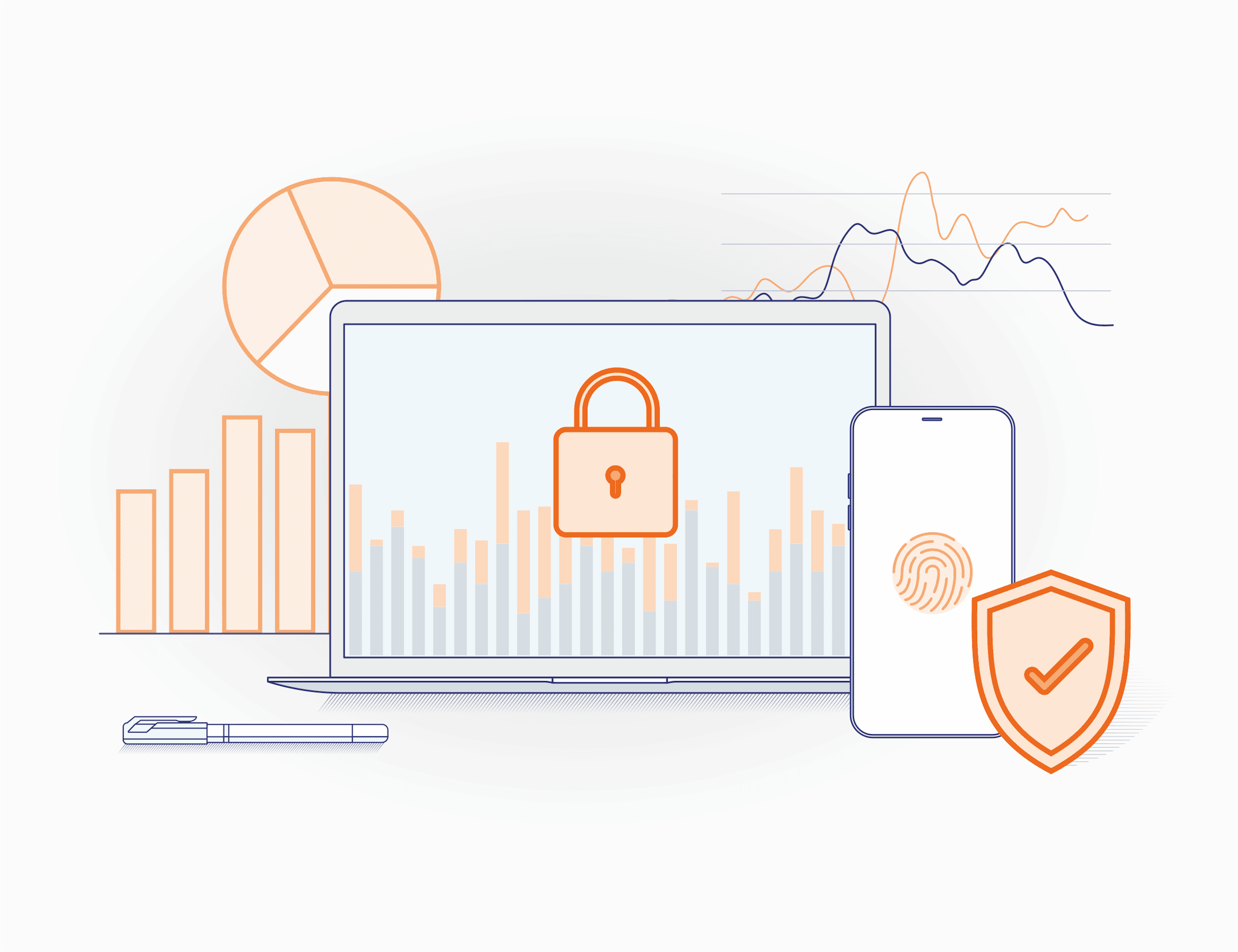Introduction to Device Fingerprinting


Device fingerprinting is a sophisticated technique for tracking and identifying laptops, smartphones, and other devices according to their unique features. It is a crucial tool for Fintech organizations to improve digital safety and prevent fraud.
In this article, we will discuss what device fingerprinting is, what it does, and how it may help the Fintech industry maintain customer safety and ensure effective risk assessment.
Device fingerprints help to generate a unique identification for a device. The process entails gathering comprehensive data about the hardware, software, and gadget settings. Also, it helps to create a thorough user profile by compiling a range of data points and attributes, including the operating system, browser type, screen resolution, and installed plugins.
This profile, also known as "device fingerprint," aids in the device's high-accuracy monitoring and identification over time. Device fingerprinting does not rely on cookies, unlike common tracking techniques. Instead, it uses the device's built-in qualities to increase the ability to promptly detect and prevent fraud risks.
This technique concentrates on information provided by web browsers. Every browser has a different set of specs that can be recorded and examined. The system monitors different parameters including:
- user agent string to identify the OS, device type, and browser version;
- time zone settings to compare them with real-time data and detect anomalies;
- installed plugins and fonts to detect newly installed untypical software;
- other device-assisted parameters like screen resolution, RAM, storage, etc.
Each browser is unique. Websites may identify and follow the same browser across several sessions by combining these attributes to produce a unique browser fingerprint.
This technique is applied to mobile devices (tablets or smartphones) and their operating systems. They have parameters that differ from desktop browsers.
The system gathers data associated with the manufacturer, mobile carrier, or gadget model. Also, it examines the OS and apps installed along with network configurations.
With these specs in mind, mobile fingerprinting helps Fintech companies create a distinct fingerprint for any mobile device, enabling precise user identification even when the user switches between apps and online browsers.
The technique is particularly useful in the Fintech industry, where customers typically access services via mobile apps even if they switch between mobile browsers or applications.
The process of device fingerprinting entails gathering several data points. When brought together, they produce a special signature for every device involving:
- type of OS;
- browser version;
- screen resolution;
- installed plugins and fonts;
- language and time zone settings.
With advanced risk assessment, businesses can incorporate even more data, such as mobile carriers and device models. Additional parameters may involve IP address and connection type. When combined, these data points create a thorough and device-specific profile that ensures device fingerprinting individuality.
Despite having the same operating system and browser, two devices might be distinguished from one another by other features like installed fonts or plugins. Thorough profiling ensures a high degree of accuracy for device tracking.
Device fingerprinting consists of several fundamental stages. Installed and launched scripts that collect device attributes every time a user visits a website. These scripts gather a huge amount of data and parameters mentioned earlier.
Then, it travels to a server where analytics software processes it to produce a distinct device profile. As users interact with online sites or apps, embedded scripts start collecting and analyzing device attributes.
After being generated, the profile is kept in a database while the system compares device properties.
Here are the 4 main stages of device fingerprinting:
1. Collecting data: Scripts are launched to collect device attributes whenever a user visits a website. This contains information on the operating system, screen resolution, and type of browser.
2. Transmitting Data: A server receives the gathered data and stores it until the next stage.
3. Analyzing and Profiling Data: Analytics software processes the data on the server to provide a distinct profile for each device.
4. Identifying Risks: Based on received and processed data, the system recognizes devices and associated potential fraud risks.
The procedure ensures accurate device identification that is more effective compared to conventional tracking techniques like cookies.
Device fingerprinting makes use of several tracking strategies:
- The HTML5 canvas element is used in canvas fingerprinting to draw an image and examine how it is rendered. This method creates a distinct fingerprint by taking advantage of the tiny differences in how different devices render images.
- Small data files called browser cookies are kept in the browser to record user sessions. Although cookies are easily removed or prevented, they offer a practical means of preserving data regarding a user's activities on a website.
- Tiny, undetectable images called web beacons are used to track user behavior on websites and emails. The user's IP address, the time and date of the contact, and other data can all be gathered by these beacons.
These methods assist in obtaining the device information required to generate a fingerprint. Every approach has specific pros and cons. Although quite accurate, canvas fingerprinting can be prevented with privacy technologies.
Although they are simple to use, browser cookies can be removed. Web beacons offer a covert method of user tracking. Through the integration of these techniques, businesses may develop a strong and all-encompassing fingerprinting plan.
Device fingerprinting is a crucial tool for fraud detection and risk analysis applied by Fintech companies. Identifying devices, aids in the detection of unauthorized access as well as unusual access patterns, including logins from unidentified devices or places.
Also, companies may flag devices that seem suspicious. It is possible to designate devices linked to fraudulent activity, stopping subsequent transactions. The technique works great for cross-account fraud prevention.
Keeping an eye on suspicious activity on devices can reduce the risk of fraud. With device fingerprinting, Fintech companies can create a detailed risk profile for every user. Businesses get an effective tool to spot patterns that are associated with potentially risky actions.
By taking proactive steps against fraud, users are better protected while businesses minimize their financial losses. Device fingerprinting is not just to identify fraud but also to enforce security regulations. For instance, in the case of an unrecognized device, a corporation may request extra authentication. This guarantees sensitive data safety and access via trustworthy devices.
When confirming device identities, device fingerprinting provides a high level of statistical certainty. Because of its dependability, it is a reliable technique for anti-fraud checks and fraud investigations.
Each fingerprint is unique, which contributes to the accuracy of the fingerprinting process. It creates a detailed profile that is hard to duplicate by combining several attributes. It guarantees a high degree of accuracy. There is less chance of false positives and negatives.
On the other hand, device fingerprinting has limitations. Legal regulations restrict the process of data gathering and usage of specific device details. These limitations emphasize the necessity for businesses to strike a compromise between user privacy and accuracy. Device fingerprinting is a useful technique. However, it does not guarantee 100% results.
Companies need to maintain compliance with applicable laws and be open and honest about the information they collect.
Despite its accuracy, device fingerprinting faces some constraints:
- Privacy Tools: Tools like VPNs and anti-tracking software can alter device attributes, reducing accuracy.
- Regulations: Legal regulations limit the collection and use of certain device details, impacting the comprehensiveness of fingerprints.
One of the main problems with device fingerprinting is privacy issues. The method entails gathering a lot of user data, frequently without the user’s permission. The absence of user notice and consent is a serious problem.
The majority of consumers have little to no influence over the fingerprinting process. What’s more, they are unaware their devices are being tracked. This lack of openness has the potential to damage confidence and violate people's privacy. Device fingerprinting is being restricted by new laws like the California Consumer Privacy Act (CCPA) and the General Data Protection Regulation (GDPR).
Users must be notified about data gathered, as required by legal regulations. It involves the types of data. Laws related to data collection restrict ways in which companies can gather info.
Fintech companies must follow these rules to avoid fines and keep the trust of their users. Companies need to think about the ethical side in addition to complying with regulations. They need to provide options for users to manage their data. Fintech organizations can employ device fingerprinting ethically and responsibly by taking measures to address privacy issues and complying with legislation.
JuicyScore solution relies on effective and time-tested device fingerprinting methods. They include a set of primary and secondary probabilistic device ID parameters with 95–99%+ of uniqueness level. Our approach combines the following:
1. A set of secondary and common techniques;
2. Server-network techniques, including AI-TLS, Juicy_TCP/IP fingerprinting, and several other technologies;
3. Load tests and behavioral patterns: these methods are connected to the fact that each device's performance and behavior are distinct. Even the gadgets that were manufactured on the same assembly line and released on the same day will differ in their behavior;
4. Special techniques for creating reliable device fingerprints: we continuously examine different anomalies that cause instability, talk to industry professionals about their "normality," and consider these factors when we operate;
5. Unique architecture: Even if Web3 is widely adopted, our solution’s calculating architecture will remain unique. Adaptability is the key benefit with its rapid development that yields amazing results.
We deliver a useful tool for preventing different types of fraud and multi-accounting. With our toolkit, Fintech companies can:
Our solution significantly strengthens the account-centric systems on the online business side and allows to embedding of such ID into the decision-making system (filters, rules, models, reporting).
Device fingerprints are collected and profiles are updated continuously or during each interaction. This ensures accurate detection of any changes, enhancing security and fraud prevention.
Device emulators and simulators can try to evade fingerprinting, but advanced detection techniques often identify these anomalies. Continuous updates enhance the system's ability to detect and prevent them.
Check if device fingerprinting is enabled by using browser extensions like Privacy Badger or uBlock Origin. Another way is to inspect the network traffic using tools like Panopticlick to analyze tracking techniques on a website.
No, it does not. Clearing cookies or using incognito mode doesn't prevent fingerprinting. Browser fingerprinting uses unique device and browser parameters that are not affected by cookies or private browsing modes.

Explore how device intelligence improves fraud detection, credit scoring, and onboarding – with real-time analysis and privacy-first design.

What is application fraud, how does it work, and how to prevent it?

Understanding the role of behavioral biometrics in fraud prevention.
Get a live session with our specialist who will show how your business can detect fraud attempts in real time.
Learn how unique device fingerprints help you link returning users and separate real customers from fraudsters.
Get insights into the main fraud tactics targeting your market — and see how to block them.
Phone:+971 50 371 9151
Email:sales@juicyscore.ai
Our dedicated experts will reach out to you promptly